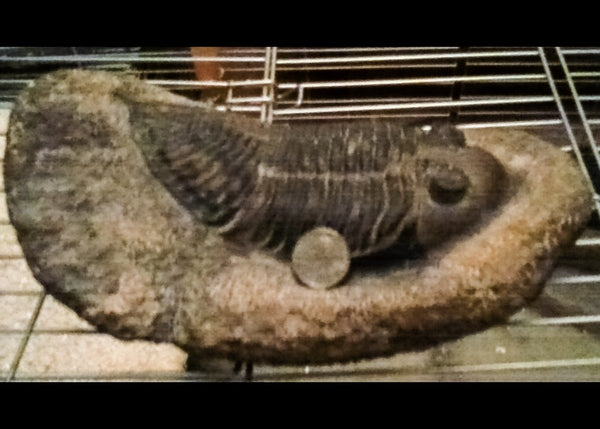Trilobites, Putting Prehistoric Bugs on Display

Asaphus kowaleskii from Russia. Cool eyestalks on this guy.
Sue, a new customer of ours, just bought one of our A029A cases to tell her story. The A029A is usually used for books or model planes. But Sue, a geologist, collects bugs. Old dead bugs. As in ancient history, before the dinosaurs, bugs. She collects trilobites.
Trilobite are considered to be the first primitive creature to have sight with some of the species having eyestalks. They ranged in size from the microscopic to the largest species Isotelus rex which was two feet long!
[Okay, a two-foot bug?! I give my son some grief because he hates/fears bugs even ants and moths, but a two-foot bug? And some of the species were known to hunt, lurking outside of the holes of their prey. Walking out of my front door in the morning only to get eaten by a bug on my way to the car—I'm kinda glad they died off before I got here.]
Trilobites were arthropods and had hard outer shells. They would molt as they grew, and that's what we have today as fossils: the hard, outer shells. Some believe that they are related to the horseshoe crab, but it is more likely that they are related to spiders.

Asaphus lepidurus from Russia. Sue's latest acquisition.
The fossils of trilobites can be found around the world, but there are regions that are known for having good specimens: Ohio, Oklahoma, parts of New York, and around St. Petersburg in the Russian Federation. According to Sue, the Russians have some of the best samples and do an excellent job of preserving the specimens. The fossils are usually found in sandstone or limestone which are “soft" rocks; it still takes some special care and tools to dig them out, but anyone can find them if they know where to look. Each area tends to have different species as trilobites lived between 521 to 252 million years ago.

All that work for a little fossilized bug!
As hobbies go, collecting trilobites looks interesting. You can find specimens for sale on the web ranging in price from a few hundred dollars to several thousand dollars, which is somewhat affordable on the low end. You can dig them up yourself if you spend time researching what you need to look for.
In doing a little bit of research for this blog, I learned that there we have had not one, but five mass extinction events in our world's history. Most of us know about the last one that took out the dinosaurs; The trilobites managed to survive the first two, although their numbers dwindled greatly during the second one. The third one is also known as “The Great Dying" took out 96% of the species that existed at the time, including the remaining trilobites.
The last photo here is Sue's pride and joy. Most women have flowers or other such items for a centerpiece on their tables; Sue has this guy: 7" long and 4" wide.

Odontochile zilchovaspis Notice the quarter to give you some idea of scale.
Click here to learn more about TRILOBITES
Or here for a Facebook page on trilobites
Click here for information on Earth's five extinction events